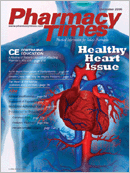Publication
Article
Pharmacy Times
An In-depth Discussion of Dyslipidemia
The term dyslipidemia describesmany acquired and geneticlipoprotein disorders causingabnormal levels of total cholesterol,high-density lipoprotein (HDL), low-densitylipoprotein (LDL), and triglycerides(Tables 1 and 21,2). Combinedwith high-fat diets, obesity, and physicalinactivity, dyslipidemia has createdepidemic atherosclerotic disease?themost common cause of death amongAmericans.3
Dyslipidemia also contributes toatherogenesis, pancreatitis, and fattyliver disease. Elevated plasma LDL levelsand reduced HDL levels clearly increasecoronary artery disease (CAD) risk andearly mortality. The association of untreatedhypertriglyceridemia with CAD isunclear, but elevated triglyceride levelsincrease pancreatitis risk.
Primary dyslipidemia results from aconfluence of factors affecting lipoproteinmetabolism. Secondary dyslipidemiastems from various pathologies, such asendocrine disorders, untreated hyperglycemia,hypothyroidism, nephrotic syndrome,chronic renal failure, or gastrointestinaldisorders. Additionally, drugs (eg,antiviral HIV agents) may induce dyslipidemia.
Manifestations of dyslipidemia mayinclude concurrent elevated cholesteroland triglyceride levels or only elevatedtriglyceride levels or low HDL levels.Metabolic syndrome is one of the mostfrequently encountered dyslipidemicconditions.4 It is closely allied with type 2diabetes. Visceral obesity and insulinresistance are common in patients withthis syndrome.
Prevention and Outcomes
Research confirms that lipid-loweringstrategies, including pharmacotherapy,reduce total coronary events, procedures(eg, bypass surgery, angioplasty),cardiovascular hospitalizations, andstroke.5-7 Primary intervention with drugtherapy in persons with low-to-moderateatherosclerotic risk, however, iscontroversial.8 Secondary prevention?lipid-lowering therapy in patients withconfirmed coronary disease and/orwith abnormal lipids?reduces mortalityand further decreases coronaryevents, surgeries, and stroke. Patientswho present with the highest riskaccrue the greatest gains.9-11
Treatment
Lowering cholesterol levels, especiallyLDL levels, can arrest or reverse atherosclerosis.Each 10% cholesterol-levelreduction is associated with an ~20% to30% reduction in heart disease incidence.12 Experts recommend first increasingphysical activity, reducingdietary cholesterol and saturated fat, andtrying weight loss.
Pharmacotherapy
Drug therapy is only rational if the typeof hyperlipoproteinemia is defined andbaseline serum cholesterol and triglyceridelevels documented. Several classesof drugs (Table 3) reduce LDL cholesterol.3,12 Should cholesterol and triglyceridelevels fail to decrease or triglyceridelevels rise significantly, medicationshould be discontinued.
Until the mid 1980s, the intestinallyactive bile-acid sequestrants and niacinwere the only proven pharmacologicinterventions available to reduce LDL levelsand decrease coronary risk. Adherence,however, was a concern, partlydue to their poor tolerability and theirtendency to increase triglyceride levels inpatients with high baseline plasmatriglycerides.
The discovery of the 3-hydroxy-3-methylglutaryl-coenzyme A (HMG-CoA)reductase inhibitors (statins) changedclinical practice due to their robusteffects on LDL cholesterol and theirimproved tolerability and safety profile.To date, clinical trials have proven thevalue of statins in reducing morbidity andmortality, including stroke. Some benefitshave been attributed to their pleiotropic(multisystemic) effects, but their propensityto reduce LDL cholesterol levelsappears to be the major cause of riskreduction.3
Recently, the introduction of theintestinally active agent ezetimibe created new monotherapy and combinationapproaches. Unlike bile-acid sequestrants,ezetimibe directly inhibits cholesterolabsorption. Ezetimibe may reduceLDL cholesterol by ~20% as monotherapyor in combination with other lipid-loweringagents.13 Unlike the bile-acidsequestrants, ezetimibe does not increaseplasma triglyceride levels. Clinicaltrials with cardiovascular end points areongoing.3
The fibrates and niacin arepreferred drugs for hypertriglyceridemia,with niacinbest for raising HDL cholesterollevels. In patients withtype 2 diabetes mellitus,niacin may aggravate insulinsensitivity. Fibrates are preferredfor patients withmarked hypertriglyceridemiafor essential pancreatitis prevention.They also modestlyimprove HDL cholesterol levels.Omega-3 fatty acids (eg,those found in marine oils)also have been used forhypertriglyceridemia, especiallywhen other therapiesfail.
When both LDL cholesterol and triglyceridelevels are elevated or when monotherapyfails, a combination of 2 drugsfrom different classes or, sometimes,triple therapy (eg, statins, niacin, and anintestinally active agent) is required.
Special Populations
Statin therapy is effective in the elderlyand is probably indicated for high-riskindividuals who have preexisting atherosclerosisafter a thorough risk-benefitanalysis is done.8,14,15 In women, dyslipidemiaincreases after menopause.16Estrogen replacement therapy maylower cholesterol levels, but combinedoral estrogen and progesterone does notprotect women from CAD and may haveadverse effects.17 Children whose parentsor grandparents had known CAD ora genetic lipid disorder should bescreened appropriately. Exhaustive lifestyleinterventions should be used firstwith children before pharmacotherapy.18
Final Thought
Along with hypertension, dyslipidemiais a silent killer, tempting patients tobecome nonadherent. Counseling onadherence and lifestyle modificationsmust be frequent and emphatic.
Dr. Zanni is a psychologist and health-systemsconsultant based inAlexandria,Va. Ms. Wick is a seniorclinical research pharmacist at theNational Cancer Institute, NationalInstitutes of Health, Bethesda, Md.Views expressed in this article arethose of the authors and not those ofany government agency.
For a list of references, send a stamped,self-addressed envelope to: ReferencesDepartment, Attn. A. Rybovic, PharmacyTimes, Ascend Media Healthcare,103 College Road East, Princeton, NJ 08540;or send an e-mail request to:arybovic@ascendmedia.com.







